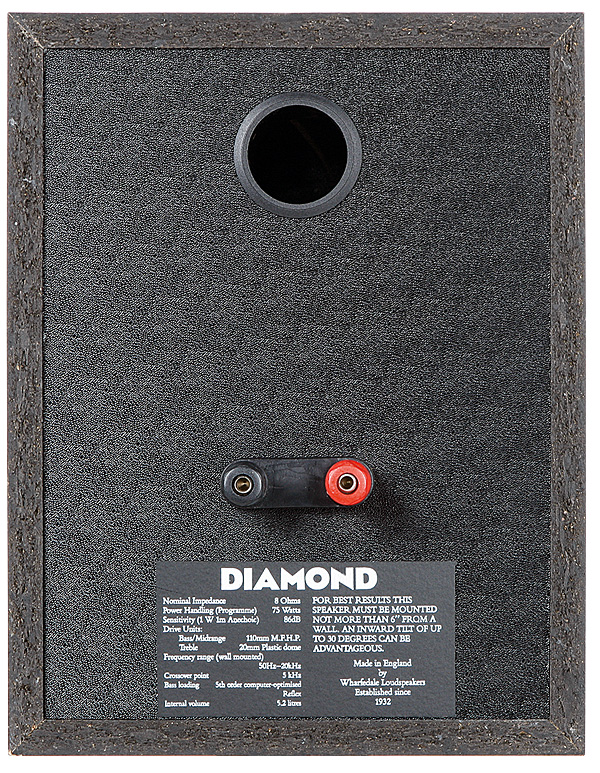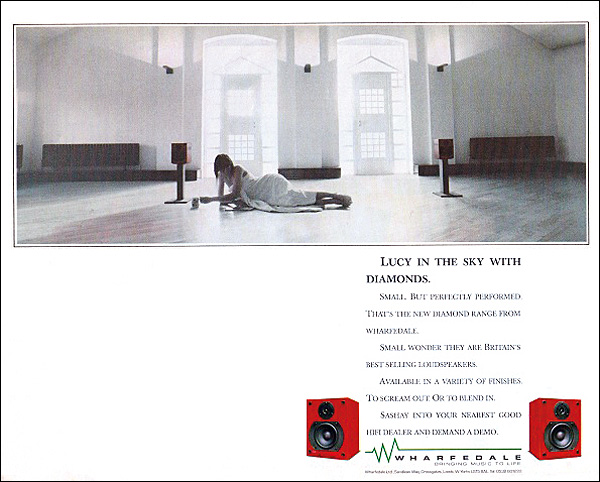Wharfedale Diamond loudspeaker Page 2
Four being an unlucky number in the Far East where Wharfedale traditionally sold well, next we got the Diamond 5. By the mid '90s, the fashion was for moulded plastic front baffles and the new speaker had just this. It brought a more refined sound too. Power handling of the standard speaker was now up to that of the Pro of several years previously – 100W – while the rear of the speaker sported a plaque proclaiming 'Hand made in Yorkshire'. The Diamond 6 that followed – a very minor update – was the last to have this.
Kevlar Comes
By the late '90s, the Diamond 7.1 was on dealers' shelves, again with a moulded front baffle. The .1 suffix denoted that the company was now producing a range of Diamond speakers, including small floorstanders. In 2001 the 8.1 arrived, and by now the Wharfedale brand had left former owners the Verity Group, and was now the property of the Taiwan-based International Audio Group (IAG).

The 8.1 was the first Diamond to use Kevlar in its mid/bass unit and this was paired with a synthetic fabric tweeter. It sounded quite different to the old generation – tighter, lighter, cleaner and less coloured – making it a lot of loudspeaker for £120.
In 2005 came the launch of the 9.1, which had a smoother sound. Now magnetically shielded, it featured a 25mm soft dome tweeter and 125mm mid/bass driver – again a Kevlar cone but now coloured black instead of yellow. The curved MDF cabinets had extensive bracing to reduce resonances and boasted an attractive vinyl wrap finish.
A special edition of 2000 Diamond 9.1s was made in 2007 to mark the company's 75th anniversary. These were finished in oiled walnut veneer, as seen on the company's £14,000 flagship Airedale Heritage loudspeaker. Other features included an Airdale-style magnetic, flush-fitting 'heritage' grille, and a champagne gold coloured alloy trim around the drivers.
![]() David Listens
David Listens
Properly set up on tall speaker stands – and as the company suggested, no more than six inches from the wall and with up to 30° of toe-in – this speaker still sounds better than it really has a right to, today. Our sample, a first-gen model with speaker binding posts, responded well to being driven by a good budget or mid-price integrated amplifier. On its release the speaker received a mixed critical reaction. The hi-fi press treated it as something of a curio, not quite seeing its potential. A recurring theme in reviews was that you could buy a larger speaker for less money – which missed the point. Still, the Diamond was widely praised for its bouncy and propulsive sound, and its tidiness considering its modest price.

Cue up a period '80s hit record, such as Grace Jones' 'Slave To The Rhythm' [ZTT 12IS 206], and you can instantly hear that it's in the midband that the Diamond really rocks. The small polypropylene mid/bass driver proves clean enough to give an impressive window on the music, and integrates well with the tweeter in the time domain. This makes for an all-of-a-piece sound with few of the drawbacks of its price-rival contemporaries.
It's at the frequency extremes that the Diamond's shortcomings are evident, however. Low bass is conspicuous by its absence while treble extension is limited and things seem rather opaque. It doesn't do so badly in the upper bass though – indeed this region is quite taut and tuneful, which makes up for the lack of extension through sheer force of personality.
Fruity And Rich
Interestingly, the original Diamond rather bucked the trend for the idea of mini monitors being neutral and analytical. The BBC LS3/5a had set the precedent here, yet in many respects the wee Wharfedale couldn't have been more different.
Spin up Daryl Hall And John Oates' 'I Can't Go for That (No Can Do)' from the album Private Eyes [RCA RPCD-108] – which was soaring up the singles charts shortly before the speaker hit the dealers' shelves – and tonally things sound quite fruity and rich. The Diamond can't defy the laws of physics, so tends to compress dynamics a tad at medium to high volumes, yet the result is pleasingly euphonic.

The tiny cabinets mean that the drive units are sandwiched together, which in turn helps to deliver near point-source imaging, too. In other words, the original incarnation of this classic baby box manages to make a virtue out of necessity.
Overall, the first Diamond sounds snappy and tuneful, with a surprisingly open and lyrical midband. For all its faults it is still able to get to the heart of the music and make for an enjoyable musical ride. This is at the core of its appeal – it has a cheeky 'can do' attitude and makes a virtue out of its small size, rather than apologising for it.
Buying Secondhand
Classic loudspeakers are all well and good, but they're not as easy to pick up in as perfect a condition as you might wish. Rather like secondhand cars, everything depends on how they have been used and/or abused. It's possible to pick up a near mint pair of originals that have sat on the same stands or shelf all their lives, yet many advertised for sale have been bundled into the backs of cars and driven down to student digs or thrown into the loft for 20 years, minus the original box. For this reason, it's worth waiting and shopping around to find a pair worth your hard-earned cash.
Generally, the condition of the cabinets will provide a pretty good clue as to how close to their original performance the speakers will deliver. If they've been stored well those delicate drivers will still be close to optimum.
Sometimes, though, long-term storage in damp or extremes of temperature will adversely affect the mid/bass unit surrounds. So take a close look at any photographs provided if you're buying from an online site, because it's not a ten-minute job to restore the drivers.
That said, secondhand parts are plentiful thanks to the wide availability of the speaker when new. Companies such as Anapeach can restore the classics relatively inexpensively.
Hi-Fi News Verdict
Nowadays, there's a plethora of variants of Wharfedale's baby on the secondhand market, but remember there is no connection between the original and the current Diamond 11.0 – aside from the name and concept. As vintage speakers go, the original model is the one to go for if you want the most sparkling Diamond experience. Lovers of classic budget esoterica can acquire one of these gems for under £50.























































